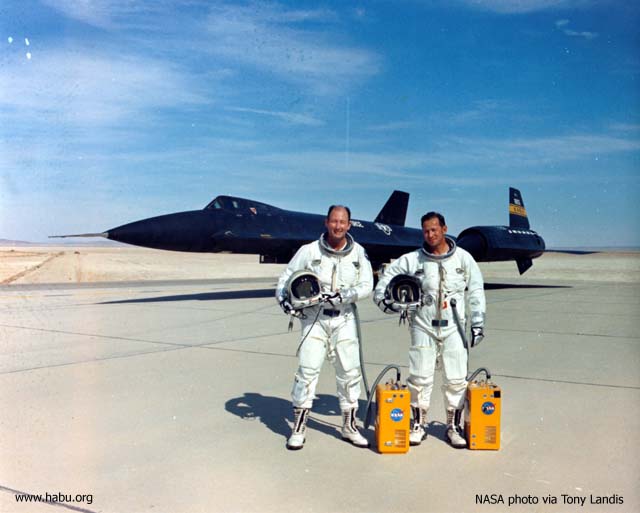60-6935

USAF photo

YF-12A #935 on the ramp at NASA FRC, April 28, 1971 - photo courtesy of NASA
YF-12 radar systems engineer Ray Scalise recalls one adventure in 935, during the US Air Force's test program:
"One of the things that was done to the YF12As at Edwards was to paint a
white cross on the bottom of the aircraft to make it visible against the
black sky so it could be spotted by a ground observer who was stationed
on the hangar roof during missions (they used high power binoculars). He
was in radio contact with the engineers in the radio room in the hangar.
"On one mission the observer said he did not need the binoculars to see
the airplane because he could see the "contrail." Airplanes con at
35,000 ft, NOT AT 80,000 ft. At about the same time my pilot noted we were
losing fuel at a very high rate. He guessed a fuel line to the left
engine had burst and was feeding raw fuel into the engine.
He immediately declared an emergency, throttled back on the engines and
began a spiral descent to Edwards since we were right overhead. I kept
my hands on the eject handle in case the airplane decided to explode.
We landed OK and when the plane stopped the base commander was there with
his car. Emergency vehicles had not arrived on the scene yet, so the
base commander drove up to the plane on the right side by the cockpits.
"Both the pilot and I egressed the aircraft by jumping on the roof, then the
hood of the car and started to run away from the bird. It looked like it
had just come out of a car wash and was leaking fuel all over the
runway. I still do not know why it did not explode. YEAH, the fuel was
of low volatility, but come on!
"Anyway, because I was carrying almost double my weight (the pressure suit weighs 35 lbs and the parachute weighs 70 lbs; I only weighed 120 lbs), I was
concerned about falling off the airplane and breaking my neck. SO...I walked down the chine on my spurs to keep from slipping on
the wet skin (the spurs were strapped to your boots, and were used to hook into cables on the seat which were designed to pull your feet back into the seat to prevent leg loss during an ejection). In doing so I punched a couple of holes in the upper chine skin. Thus, I have always contended I "signed my signature" to the plane.
"If you are ever in Dayton, Ohio at the air museum, there you can see the patches on the upper chine, right side by the rear cockpit where they repaired my 'signature.'"
Click here for more stories from Ray...

NASA crewmen Fitz Fulton and Don Mallick with 935 - NASA photo via Tony Landis
More photos are available at NASA's web site and our NASA/Dryden Mirror Page.

935's last final approach - photo courtesy of Lockheed Martin
The only surviving YF-12A, 935 was delivered to the U.S. Air Force Museum at Wright-Patterson AFB near Dayton, Ohio, by Col. Jim Sullivan and Col. Richard Uppstrom on Wednesday, November 7, 1979, and has been on permanent display ever since. The museum is also home to an SR-71 (61-7976).
Click here for more photos and info.
Click here for a NASA video of this bird in action.
17950
17951 17952
17953 17954
17955 17956
17957 17958
17959
17960
17961 17962
17963 17964
17965 17966
17967 17968
17969
17970
17971 17972
17973 17974
17975 17976
17977 17978
17979
17980
17981
Back to the Blackbird Photo Archive index
Back to the main page
Copyright © 1998-2000 Habu.Org


